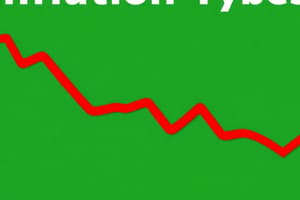Podcast
Questions and Answers
What is the equation for expected inflation based on last period’s actual inflation?
What is the equation for expected inflation based on last period’s actual inflation?
The equation is $p_e = p - 1$, where $p$ represents actual inflation from the previous period.
How can disinflation be achieved regarding demand growth?
How can disinflation be achieved regarding demand growth?
Disinflation can be achieved by slowing down demand growth significantly, which reduces the inflation rate.
What does the 'cold turkey' remedy for inflation entail?
What does the 'cold turkey' remedy for inflation entail?
'Cold turkey' involves a sudden and significant reduction in demand growth, such as dropping from 10% to 4%.
What is the relationship between supply shocks and supply inflation?
What is the relationship between supply shocks and supply inflation?
Signup and view all the answers
How did oil price shocks contribute to inflation in the 1970s and early 1980s?
How did oil price shocks contribute to inflation in the 1970s and early 1980s?
Signup and view all the answers
What are farm price shocks and their possible economic impact?
What are farm price shocks and their possible economic impact?
Signup and view all the answers
What role does expected inflation play in economic output according to the Short-Run Phillips Curve?
What role does expected inflation play in economic output according to the Short-Run Phillips Curve?
Signup and view all the answers
What immediate effects result from a sudden reduction in demand growth on inflation and GDP?
What immediate effects result from a sudden reduction in demand growth on inflation and GDP?
Signup and view all the answers
How did productivity growth trends from 1965 to 1980 contribute to inflation?
How did productivity growth trends from 1965 to 1980 contribute to inflation?
Signup and view all the answers
What is the impact of dollar depreciation on import prices and domestic inflation?
What is the impact of dollar depreciation on import prices and domestic inflation?
Signup and view all the answers
What were the effects of the oil price spikes in the 1970s on inflation and GDP?
What were the effects of the oil price spikes in the 1970s on inflation and GDP?
Signup and view all the answers
Identify and explain one adverse and one beneficial supply shock.
Identify and explain one adverse and one beneficial supply shock.
Signup and view all the answers
Describe how the relationship between unemployment and inflation is characterized by economists.
Describe how the relationship between unemployment and inflation is characterized by economists.
Signup and view all the answers
What role did dollar appreciation play in inflation between 1995 and 2002?
What role did dollar appreciation play in inflation between 1995 and 2002?
Signup and view all the answers
How did productivity growth from 1995 to 2004 affect inflation levels?
How did productivity growth from 1995 to 2004 affect inflation levels?
Signup and view all the answers
What challenge do policymakers face during adverse supply shocks?
What challenge do policymakers face during adverse supply shocks?
Signup and view all the answers
What is demand-pull inflation, and what factors contribute to it?
What is demand-pull inflation, and what factors contribute to it?
Signup and view all the answers
How does an increase in aggregate demand affect the AD curve?
How does an increase in aggregate demand affect the AD curve?
Signup and view all the answers
Explain the significance of the output ratio exceeding 100%.
Explain the significance of the output ratio exceeding 100%.
Signup and view all the answers
What is the relationship between the short-run aggregate supply (SAS) curve and price levels?
What is the relationship between the short-run aggregate supply (SAS) curve and price levels?
Signup and view all the answers
Describe the long-run implications when wages adjust in response to a rising output ratio.
Describe the long-run implications when wages adjust in response to a rising output ratio.
Signup and view all the answers
What impact do oil price shocks have on the economy, particularly regarding supply inflation?
What impact do oil price shocks have on the economy, particularly regarding supply inflation?
Signup and view all the answers
How can changes in exchange rates influence inflation and output?
How can changes in exchange rates influence inflation and output?
Signup and view all the answers
What are the different types of supply shocks and their potential effects?
What are the different types of supply shocks and their potential effects?
Signup and view all the answers
Study Notes
Macroeconomics Second Semester Lecture 1
- Subject: Inflation: Causes and Cures
- Lecturer: Dr. Zeeshan Atiq
- Institution: University of Karachi
Inflation Rate
- Continuous Inflation: Sustained increase in aggregate demand causes inflation. Single events causing price jumps do not explain continuous inflation.
- Impact of Inflation: Long-term small annual inflation rates significantly increase the price level, eroding purchasing power and savings.
- Causes of Inflation: Driven by shifts in aggregate demand and supply, with demand shocks primarily affecting inflation and GDP fluctuations.
- Economic Trade-offs: Reducing inflation can require recessionary periods, and the Fed may need restrictive policies to manage excessive aggregate demand.
Output Ratio
- Understanding the Output Ratio: Compares actual real GDP to natural real GDP.
- Above 100%: Actual real GDP is higher than natural real GDP.
- Below 100%: Actual real GDP is lower than natural real GDP.
Demand and Supply Shocks
-
Demand Shocks:
- Positive: Increases aggregate demand, raising both inflation and the output ratio temporarily above 100%.
- Negative: Decreases aggregate demand, lowering both inflation and the output ratio (e.g., recessions).
-
Supply Shocks:
- Adverse: Increases inflation while reducing the output ratio (e.g., oil price hikes).
- Beneficial: Decreases inflation while increasing the output ratio (e.g., technological advancements).
Key Insights
- Inflation and the output ratio can rise or fall together during demand shocks.
- Supply shocks can cause inflation and the output ratio to move in opposite directions.
Real GDP, Inflation Rate, and the Short-Run Phillips Curve
- Demand-Pull Inflation: Continuous increase in demand raises the price level, caused by factors like large government budget deficits and rapid money supply growth.
-
Understanding the Graph (Figure 2):
- Aggregate Demand (AD): Shows total demand in the economy.
- Short-Run Aggregate Supply (SAS): Shows the relationship between output and price level in the short run.
- Output Ratio: Measures the ratio of actual to natural real GDP.
- Initial Equilibrium (E0): Point of intersection of AD and SAS curves, where initial price index (Po) and nominal wage rate (Wo) are both 1.0.
-
Short-Run and Long-Run Supply Curves:
- SAS Curve: Positively sloped, higher output raises price level.
- LAS Curve: Vertical at 100% output ratio, long-term supply not affected by price level.
Effects on Wage and Output
- Rising Output Ratio: If output ratio exceeds 100%, it indicates higher actual GDP than natural GDP, leading to upward pressure on wages, shifting the SAS curve upward.
- Long-Run Implications: Over time, wages adjust, returning the output ratio to 100% and restoring long-term equilibrium.
How Continuous Inflation Occurs
- Scenario 1 (One-Time Increase in Aggregate Demand): Aggregate demand shifts to AD₁, moving economy from E₁ to D. Necessary adjustment for maintaining equilibrium by shifting demand again, resulting in a higher price level, with upward pressure on wages.
- Scenario 2 (Continuous Increase in Aggregate Demand): Constant increase in aggregate demand to maintain output ratio. The economy follows an upward path, indicating continuous inflation.
The SP Curve: Short-Run Phillips Curve
- SP Curve Overview: Plots inflation rate against the output ratio, showing the relationship between real GDP and inflation. Named after A. W. H. Phillips.
- Upward Slope: Higher output ratios are associated with higher inflation rates.
- Continuous Inflation: To maintain an output ratio above 100%, aggregate demand must continuously increase.
- Non-Equilibrium State: At points above 100% output ratio, the economy is not in long-run equilibrium due to wages lagging behind prices.
Why the SP Curve Slopes Upward
- Sensitivity to Demand: Higher aggregate demand raises material prices, increasing inflation.
- Wage Pressure: Continuous upward pressure on wages due to insufficient anticipation of inflation in labor contracts.
The Adjustment of Expectations
- Inflation and Expectations: Initially, people do not anticipate inflation in labor contracts. The price level rises faster than nominal wages, lacking inflation adjustments.
- Impact on the SP Curve: When people start to expect inflation, the short-run Phillips Curve (SP curve) shifts upward.
- Shift Due to Expected Inflation: When a 3% inflation rate is expected, the SP curve shifts upward to SP₁. The new equilibrium is E₂ where expected inflation matches actual inflation at 3%.
Recession as a Cure for Inflation
- Achieving Disinflation: Disinflation refers to a significant decrease in the inflation rate.
- Methods: Reversing the process that caused inflation, slowing down demand growth (x).
- The "Cold Turkey" Approach: Involves a sudden reduction in demand growth (e.g., from 10% to 4%). This can cause a recession by leading to a decline in the output ratio.
Types of Supply Shocks
- Supply Inflation: Caused by sharp changes in business costs unrelated to nominal GDP growth (e.g., oil shocks).
- Oil Shocks: A significant cause of supply inflation, especially in the 1970s and early 1980s. Various examples of adverse and beneficial shocks are detailed.
- Farm Price Shocks: Related to rising prices of raw materials, especially farm products, usually temporary.
- Import Price Shocks: Foreign exchange rates affect import prices; dollar depreciation increases import costs leading to higher inflation, while appreciation has the opposite effect.
- Productivity Growth Shocks: Rapid productivity growth makes hiring workers cheaper, influencing inflation.
Relationship Between Unemployment Rate and Inflation Rate
- Trade-off: Economists frequently discuss trade-offs between unemployment and inflation.
- Strong Negative Correlation: There's a strong negative correlation between the unemployment rate and the output ratio.
- Mirror Image: The relationship between the output ratio and inflation rate mirrors the relationship between the unemployment rate and inflation rate.
Nominal GDP Growth and Inflation
- Nominal GDP (X): Product of price level (P) and real GDP (Y).
- Growth rate of nominal GDP (x) equals the sum of inflation rate (p) and growth rate of real GDP (y).
Factors Affecting Unemployment
- Aggregate Demand Factors:
- Private Sector: Business and consumer optimism, increases in foreign income boosting net exports.
- Government Sector: Higher government spending, lower tax rates, higher money supply.
Okun's Law
- Arthur M. Okun introduced the relationship in the 1960s.
- Negative Slope: Output ratio decreases, unemployment rate increases.
- Change in Unemployment Rate: 0.5 times the percentage change in the output ratio (in the opposite direction).
Studying That Suits You
Use AI to generate personalized quizzes and flashcards to suit your learning preferences.
Related Documents
Description
Delve into the key concepts of inflation, its causes, and potential cures in this first lecture of the second semester of Macroeconomics. Learn about the impact of continuous inflation on purchasing power and the necessary economic trade-offs in managing inflation. This insightful lecture by Dr. Zeeshan Atiq from the University of Karachi covers essential macroeconomic principles.




